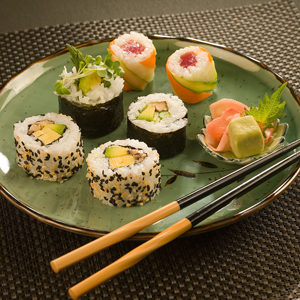Chinese Culture >> Chinese Food Articles >>
How to Find Great Sushi
 If
you have easy access to a Japanese translator who can help you find the best
sushi,
go for it. That way you can delve deep into the heart of Tokyo town or Little
Japan, to restaurants that cater especially to Japanese.
If
you have easy access to a Japanese translator who can help you find the best
sushi,
go for it. That way you can delve deep into the heart of Tokyo town or Little
Japan, to restaurants that cater especially to Japanese.
Since 99% of Sushi restaurants in the U.S.A. have English on their menu, you
probably won’t need that Japanese translator just to find good sushi. A
professional translation might be fun if you are obsessed with learning more
about Japanese culture. Think of how fun it would be to get a lesson in Japanese
as you order your sushi.
BUT, For those of you who are not linguistic enthusiasts, but just want great
sushi, follow these steps to find the freshest platter:
Go for High Turnover
In most cases “high turnover” is a negative point for a business. But we’re
talking about high turnover of fish, in this case. You want a restaurant with a
constant flow and turnover of customers, because that means the fish is getting
eaten quickly. A steady flow of customers means a steady movement of fish. You
don’t want fish that has been sitting around. That’s when you get odorous plates
that make you a tad queasy. It might taste okay but something feels wrong about
it. Hours later you might get an upset stomach, or worse. Plus, with the
considerable price of sushi, you don’t want to end up with something
unappetizing.
Don’t get Sushi at the Store
Those little
sushi
containers at the supermarket are not worth it, even for a quick fix. Unless you
have a store with it’s own sushi restaurant, with lots of customers, that sushi
box has probably been sitting there for hours. Look at it closely. Is there an
expiration date? Sushi should be eaten the same day it is made. Can you ask the
chef how recently it was made? If the chef is not around, inspect the condition
of the fish. Even the brightest, freshest looking sushi may smell stinky when
opened. The price on store-bought sushi is usually not much different from
buying it directly in a sushi restaurant. So, for a fast grocery pick you may
want to opt for a salad or sandwich instead. Save your sushi experience for when
you can get it really fresh.
Go where everyone else is going
A barren
sushi
place is suspect. If the lunch hour brings only a couple customers, don’t go
there (unless it is a brand new restaurant, then you may want to give it a
chance). You want the place that is crowded with sushi lovers. Also, avoid the
restaurants that have slimy pieces of fish on display.
Take a long look at the chef and wait staff
Do the chef and wait staff carry themselves with pride? If so, they are probably
proud of their restaurant, an excellent sign. If instead you notice a depressed,
embarrassed look, it could be connected to the quality of food or dismal state
of business. A successful business boosts the spirit of everyone involved. Look
for that spirit.
In the end, there will always be some risk when trying a new sushi restaurant,
but that’s part of the fun! Trying a small dish to start can’t take you too far
wrong. At the worst you’ll be vomiting for hours, at the best you’ll have a hot
spot to tell all your friends about. Once your trust is established in a
restaurant, be sure to branch out and try some unfamiliar dishes.
About the Author
About the Author: Amy Brevard is a Freelance Writer working with Innuity. For more information about a Japanese translator or professional translation go to Multiling
